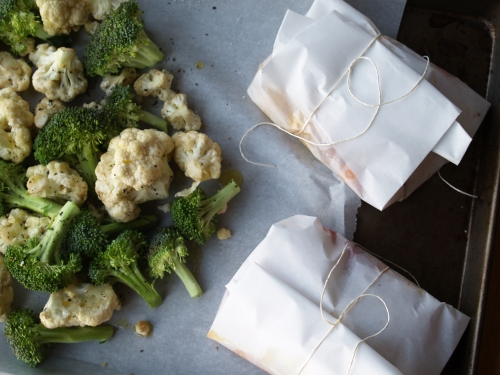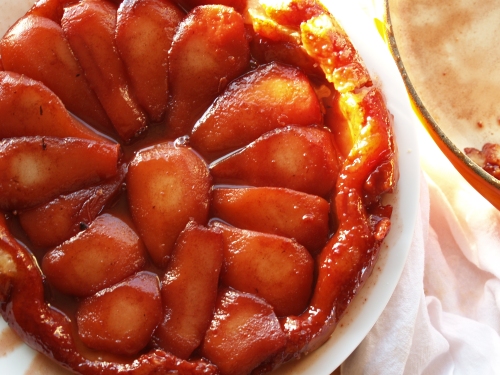I failed my first test today.
Not the first one in my life, of course. Just the first one of my cooking techniques course.
Today was knife skills. After waking up at 8 am (on a Sunday!) and fortifying myself for the drive through the first inches of snow on the ground (in October!) with a strong cup of coffee and over easy egg on toast, I sat myself down on a little chair with a little arm desk attached. I felt like I was back in high school.

Sitting in these little chairs, we learned the anatomy of a knife from tang to tip. How to hold a chef’s knife. How to sharpen a knife. How to test the sharpness of a knife by slicing right through a piece of paper.
We learned knife etiquette. Keep knives sharp. Always cut away from yourself. Never hand a knife to another chef; place it on the table and let him pick it up himself. Walk with your knife pointed downward. “A falling knife has no handle; do not attempt to catch it.” Clean and dry your knives as quickly as possible. Never put your knives in a dishwasher. Keep knives sharp.
We chose our knives and made our way over to a large stainless steel table set with a pile of vegetables at each of a dozen stations. We wrapped an apron around our waists and tucked a towel in the ties. I positioned myself in front of the stove and salamander to keep warm. We set our cutting boards down on a cloth so they wouldn’t move, placed a dough scraper under the right side of the board.
We practiced holding our knives: choke up on the bolster, just in front of the handle. We practiced our “claw” hand – curling our left fingers under and our thumbs in to hold our vegetables without slicing off a finger.
And then we set to work. We cried our way through a fine chop of an onion. We minced garlic and turned it into a paste with the tip of our knives.
We made batonnets from potatoes – just a fancy name for cutting them into french fry shapes. Then we diced cubes of all sizes. We medium diced zucchini (1/2 inch all around). We seeded peppers and tomatoes and cut them into a small dice (1/4 inch). We julienned carrots and bruniosed – cut them into teeny tiny cubes (officially 1/8 inch). I quickly learned that uniformity will be my struggle.
Next we sliced. Carrots into rondelles (coins), half moons and quarter moons. Celery into diagonal/bias cuts. Fennel shaved as thin as possible (mandoline optional).
Herbs followed. A few quick chifonnades of parsley and we had a nice fine chop without bruithsing the leaves and losing the flavors onto the board. Tiny slices of chives – as thin as possible. Rosemary chopped super fine. Get the picture with herbs? Teeny teeny tiny.
We also suprêmed oranges. I ate mine.
Finally we got cooking. Vegetables into some olive oil with canned tomatoes. Pasta into a huge pot of boiling salted water, and then into the vegetables. Parsley, chives, and garlic paste into melted butter, then butter brushed onto a split baguette and tucked into the oven. Potatoes soaking in water dried off and dropped into hot oil. And then tossed with parmesan and rosemary.
And then we dined.
When I got home, I tested my knives. I held up in front of me a piece of paper between two fingers. I held my favorite knife above the edge of the paper and slowly lowered it, waiting for the swift swoosh of a nice long cut. Instead, barely a crinkle. The paper buckled under the weight of the knife, crunched a bit, and remained intact. I honed the knife and tried again. Crunch. Second knife. Crunch. Third. Crunch. Fourth. Crunch.
Oy.
But after failure, success.
Using some of my new techniques and holding my (dull) knife correctly for once, I rough chopped many of the same ingredients from the morning into a stew for the week.
Moroccan beef and chickpea tagine.
I’m working on one pot meals. This is my first. And it’s good enough for company. Especially in front of a fireplace.
A tagine is a north African stew made in a dish called a tagine with a tight-fitting, pointy domed top. It is traditionally served over couscous. The inspiration for this recipe comes from my friend Sarah at FoodBridge (she actually made couscous from scratch!) and Deb at Smitten Kitchen and I used what I could find in my fridge. Butternut squash would be a great addition. When I made this, I made two versions – one with meat and one veggie. For the veggie version, I added extra chickpeas and made the stew in pretty much the exact same way. My friend Ilana told me that her Moroccan friends use really large chunks – whole carrots, potatoes and zucchini cut in half – and each person cuts off a few pieces of what they want. I’m going to try that next time.
If you don’t want to use canned chick peas, you’ll need prepare dried chickpeas a day in advance. Sort through the dried chickpeas to remove any black ones or little stones. Soak them in at least three times the amount of water overnight (~10-12 hours) with a large pinch of baking soda. Rinse them off the next day and pour into at least double the amount of boiling water. Reduce to a simmer and cover for about 1.5 hours until tender but not falling apart. Drain and add to stew.
– 2-3 pounds of stew meat
– olive oil
– spices to taste (I like a lot of spice, and have provided approximate measurements):
– cumin (1-2 T)
– cinnamon (1/2 – 1 T)
– nutmeg (pinch)
– dried coriander (1/2 – 1T)
– turmeric (1/4 t)
– ginger powder (1/2 t)
– several saffron strands seeped 5 minutes in hot water)
– 8-10 C water
– 1 large onion
– 3-4 large carrots (or 2 large handfuls of baby carrots)
– 3-4 celery stalks
– 3-4 thin-skinned potatoes
– 2 large zucchini
– 3-4 C chickpeas
– salt and pepper
Braise. Heat enough olive oil to cover the bottom of a large heavy pan (I used a large 6 3/4 quart cocotte) until it glistens. Cut meat into smaller pieces (3/4 to 1-inch cubes) and brown with half the spices. Add the water and bring to a boil. Scrape up the good bits stuck to the bottom of the pan. Turn down the heat and simmer, covered, for 30-40 minutes until the meat starts to get tender.
Prep the vegetables. Rough chop onions into large pieces. Cut baby carrots in half or peel and cut carrots into 1-inch pieces. Cut celery into 1-inch pieces. Scrub the potatoes and dice into 1-inch cubes. Cut zucchini into large half moons.
Simmer. When meat is tender, add harder vegetables – onions, carrots, potatoes – and the rest of the spices, salt, and pepper. Simmer, covered, for another 30-40 minutes until vegetables are tender. Add zucchini and simmer for another 20 minutes. Add chickpeas in the last 10 minutes.
Serve. Pour meat, vegetables, and broth over couscous (or Israeli couscous, sometimes called p’titim in Hebrew or acini de pepe in Italian)































